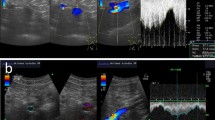Summary
The blood flow of the dog urinary bladder measured by radioactive microsphere technique was compared to the clearance of locally injected 99mTechnetium pertechnate (99mTc) in the bladder wall. In semilogarithmic plots the 99mTc washout curves showed a multiexponential course. From the initial slopes (median 5.7 min) the bladder blood flow was calculated to be only 30–62% of the results obtained from the radioactive microsphere technique (blood flow in the muscular layer 21.7–44.8 ml/ 100 g/min). These lower values imply that the rate of removal of the hydrophilic tracer 99mTc at these flow rates is limited by the capillary diffusion capacity. The multiexponential curves reflect recirculation and excretion of 99mTc by the kidneys with accumulation of 99mTc in the bladder. It is concluded, that clearance studies of locally injected 99mTc in the bladder wall are unable to evaluate bladder blood flow.
Similar content being viewed by others
References
Andersson PO, Bloom SR, Mattiasson A, Uvelius B (1985) Changes in the vascular resistance in the feline urinary bladder in the response to bladder filling. J Urol 134:1041
Archie JP, Fixler DE, Ullyot DJ, Hoffman JIE, Utley JR, Carlson EL (1973) Measurement of cardiac output with and organ trapping of radioactive microspheres. J Appl Physiol 35:148
Buckberg GD, Luck JC, Payne B, Hoffman JIE, Archie JP, Fixler DE (1971) Some sources of error in measuring regional blood flow with radioactive microspheres. J Appl Physiol 31:598
Bülow J and Tøndevold E, (1982) Blood flow in different adipose tissue depots during prolonged exercise in dogs. Pflügers Arch 392:235
Di Lorenzo PA, Brown DW, Walker SH, Dern PL, Goltz RW (1971) Technetium-99m Pertechnate disappearance studies in normal and psoriatic skin. J Invest Dermatol 56:39
Dunn M (1974) A study of the bladder blood flow during distension in rabbits Br J Urol 46:67
Eldrup J, Krogsgaard OW, Nielsen SL (1985) Distribution of Xenon133 in mice from the urinary bladder. Eur J Nucl Med 10:369
Fan F-C, Schuessler GB, Chen RYZ, Chiens S (1979) Determinations of blood flow and shunting of 9-and 15-μm spheres in regional beds. Am J Physiol 237:H25
Finkbeiner A, Lapides J (1974) Effect of distension on blood flow in dogs urinary bladder. Invest Urol 12:210
Gatenbeck L, Johansson B, Strømberg L, (1987) Blood perfusion of the male genital organs-an experimental study in the rat. Urol Res 15:291
Hales JRS (1974) Radioactive microsphere techniques for studies of the circulation. Clin Exp Pharm Physiol 31 [Suppl 1]:31
Hohlbrugger G (1987) Changes of hypo-and hypertonic sodium chloride induced by the rat urinary bladder at various filling stages. Eur Urol 13:83
Holstein P, Trap-Jensen J, Bagger H, Larsen B (1983) Skin perfusion pressure measured by isotope washout in legs with arterial occlusive disease. Clin Physiol 3:313
Johannsen B, Beerger R, Schomäcker K (1980) The binding of Technetium compounds by human serum albumin Radiochem Radioanal Lett 42:177
Kety SS, Schmidt CF (1945) The determination of cerebral blood flow in man by use of nitrous oxide in low concentration. Am J Physiol 143:53
Lassen NA (1964) Muscle blood flow in normal man and in patients with intermittent claudication evaluated by simultaneous Xe133 and Na24 clearances. J Clin Invest 43:1805
Lassen NA, Henriksen O, Sejrsen P (1983) Indicator methods for measurement of organ and tissue blood flow. In: Shepherd JT, Abboud FM (eds) The cardiovascular system, vol 3, sect 2. Am Physiol Soc, Bethesda, Maryland, pp 21
Mehrotra RML (1953) An experimental study of the vesical circulation during distension and in cystitis. J Pathol Bact 66:79
Miller W (1979) Technetium99m biorouting. In: Early PJ, Razzak MA, Sodee DB (eds) Nuclear medicine technology, Mosby Company, St. Louis Toronto London, p 544
Moustafa HF, Hopewell JW (1976) The evaluation of an isotopic clearance Technique for the measurement of skin blood flow in the pig. Microvasc Res 11:147
Nemeth CJ, Khan RM, Kirchner P, Adams R (1977) Changes in canine bladder perfusion with distension. Invest Urol 15:149
Sarma KP (1981) Microangiography of the bladder in health. Br J Urol 53:237
Trap-Jensen J, Lassen NA (1970) Capillary permeability for smaller hydrophilic tracers in exercising skeletal muscle in normal man and in patients with long-term diabetes Mellitus. In: Crone, C, Lassen NA (eds) Capillary permeability, Alfred Benzon Symposium II, Munksgaard, Copenhagen, p 135
Tøndevold E, Eliasen P (1982) Blood flow rates in canine cortical and cancellous bone measured with 99mTc-labelled human albumin microspheres. Acta Orthop Scand 53:7
Author information
Authors and Affiliations
Rights and permissions
About this article
Cite this article
Krøyer, K., Bülow, J., Nielsen, S.L. et al. Urinary bladder blood flow. Urol. Res. 18, 223–226 (1990). https://doi.org/10.1007/BF00295852
Accepted:
Issue Date:
DOI: https://doi.org/10.1007/BF00295852




